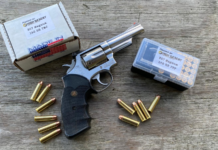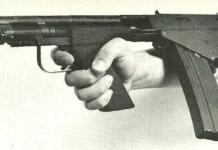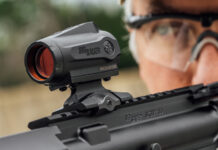While the M1 Garand gets all the love for being the “greatest battle implement ever devised”, we’ve covered here the ways it could have been even better if the logistics had been in place to support it in .276.
Where the 30.06 really had its glory days was in the M1903 series. It was the American Expeditionary companion of WWI and an unsung hero of WWII. It supported those troops who had not received the M1 Garand yet, production hadn’t met deploying troops requirements yet, as it was only adopted a couple year prior and the United States had been trying to stay out of the war.
The M1903, meanwhile, was in full service and circulation. It was a well fleshed out Mauser action where the new 30.06 caliber in a relatively light (150gr) round and studies in barrel length landed on a fairly short (for the era) 24 inches making the rifle only about 43 inches. This relative size would remain consistent all the way through the M16A4 at 39.5 inches. Other systems were all specialty niche weapons for specialized combat arms like paratroopers or support soldiers. Several systems like the M1 Carbine and M3 were pushed forward during the war in the same way the STG44 and STG45 were developed by the Germans.
Anyway, back to the ’03. It came about after the Americans had a very very rough time in the Spanish-American war against the Masuer 98 armed Spanish, even outnumbering the Spanish by magnitudes.
In short, the ability to mag load from a stripper clip and run a smooth bolt action that can feed and eject and be fed again to sustain a strong rate of fire from a relatively small number of troops was highly effective. If numbers of troops had been closer to parallel the Spanish could have given a very different outcome.
The US saw this, and after trying to fix the obsolete Krag, they built their own Mauser (and were sued successfully by Mauser over it) to give the US a modern fighting rifle. The 1903 was dramatically overshadowed by the Garand in its effective rate of fire while retaining parallel capabilities in practical effective range, but it was still a peer to the rest of the fighting rifles fielded at the time.
I believe that the M1903 was perfectly placed in its service slot and time period. The fact it continued to be made until 1949 is a testament to it and would see use up to Vietnam. But I retain my opinion that, by rights, we should have stopped fielding 30.06 with the M1903 and gone to .276 Garand.
In that event we may have fielded a much more modern rifle after it, one that suffered fewer of the .308’s issues. We have a habit of making less than ideal ideas work well and the .308/7.62 is proof. We’ve made that into a successful caliber that will continue to be fielded for a few decades at the least, but it exists as it does because we couldn’t give up on 30.06. Then we swung heavily to the low mass high velocity rounds, where we have also been successful and seen excellent technological gains. But now with the NGSW we are looking at a picking a round that we had an opportunity to pick almost a century ago (although probably at a lower pressure) and I will wonder how we would’ve progressed if we had picked that more efficient middle cartridge before the Brits and their EM-2. Would the AR-10 have been fielded instead of the 15? Would the FAL, which was scaled up, made a better showing? Would even the M14 have worked better, despite its significant differences from the M1?
Nobody knows, nobody can. We can only deal with today’s actual tech.
Good job on another video from Josh and Henry too. Subscribe if you have not.



